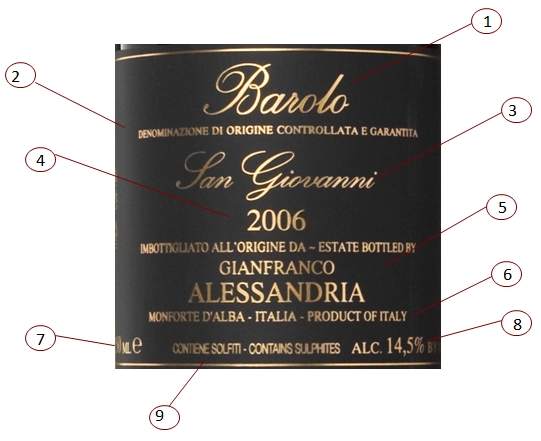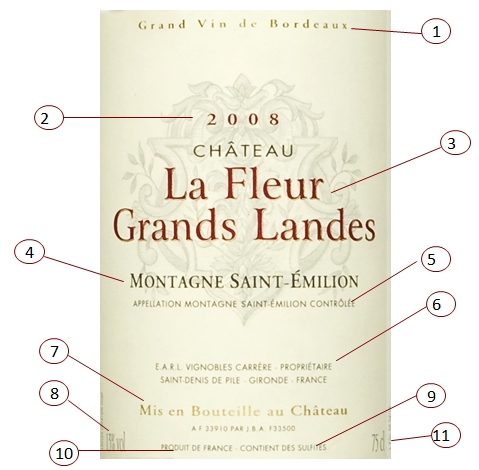
Label Description
The range of wine labels is as vast as is the world of wines. It is impossible to arrive at one, uniform label template. However, there are several pieces of information that you can find on every label.
These are, for example:
1. Name of the wine – this can be a proper name of a given wine, name of the vineyard, appellation from which the wine originates, name of the grape variety or variety coupage.
2. Name of the producer
3. Protected destination of origin (appellation):
- in France - AOC: appellation d'origine contrôlée,
- in Italy - DOC(G): denominazione di origine controllata (e garantita),
- in Spain DO(Ca): denominación de origen (calificada), etc.
In place of the appellation, a wine label may feature the following description:
- Regional wine (vin de pays, IGT - indicazione geografica tipica, currently changes to IGP – indicazione gografica protetta; vino de la tierra),
- Table wine (vin de table; vino da tavola; vino de mesa).
4. Year – the date on the bottle indicates the year of grape collection. It is not stated in the case of table wines or wines produced from grapes from different years (eg. basic champagnes)
5. Alcohol content
6. Bottle volume
7. Additional information. This may feature the following descriptions:
- reserva/riserva: this information regards the maturing of wine in barrels,
- classico (Italia expression): a parcel of several parcels inside Italian appellations characterized by better grape growing conditions,
- supérieur (superiore): serves to describe wines of the highest alcohol content and higher production standards,
- kabinett, spätlese, auslese, beerenauslese, trockenbeerenauslese, eiswein (German wines): information on the concentration of sugar in the collected grapes.
Please see below for descriptions of selected wines from Piwnica Smaków.
ITALY

1. Name of appellation
2. DOCG appellation (abbreviation) – this is a very prestigious appellation. It is the highest appellation in the Italian wine classification
3. Name of the selected line of wines
4. Year (grape collection year)
5. Imbottigliato all’origine da – bottled at the estate
6. Information on the origin – region, country
7. Volume
8. Alcohol content
9. Additional information – contains sulfites
SPAIN

1. Name of wine
2. Name of region
3. Information on the appellation
4. Country of origin
5. Year and time of maturing in barrels (crianza means that the wine matured for at least one year in a barrel and one year in a bottle)
FRANCE BORDEAUX

1. Grand vin – usually denotes the best wine from a given vineyard or producer.
2. Year (grape collection year)
3. Name of estate – wine producer
4. Montagne Saint Emilion – town/city where the vineyard is situated. A very good address yet it does not warrant high wine quality.
5. Apellation Montagne Saint Emilion Controlee – appellation, namely the protected name of origin. Grapes must come from a precisely defined area, the wine must meet a series of other conditions: defined grape varieties, method of production and maturing.
6. Vineyard owner
7. Information on the bottling of wine, In his case the wine was bottled at the estate (in exact words, in a castle)
8. Alcohol content
9. Additional information – contains sulfites
10. Country of origin
11. Bottle volume

